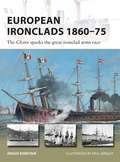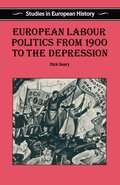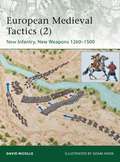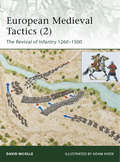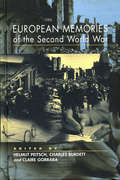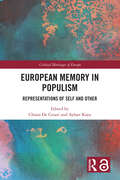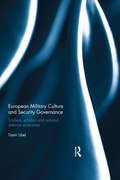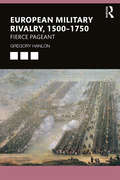- Table View
- List View
European Intruders and Changes in Behaviour and Customs in Africa, America and Asia before 1800 (An Expanding World: The European Impact on World History, 1450 to 1800)
by Evelyn S. RawskiEuropean intrusions had many impacts on invaded peoples, but less attention has often been paid to changes brought about by the encounter in everyday life and behaviour, both for the Europeans and the other cultures. What changed in diet, dress, agriculture, warfare and use of domesticated animals, for example ? To what degree were attitudes, and thus behaviours affected ? How did changes in the use of types of firearm reorder power structures, indeed lead to the rise and fall of competing local states ? Even the design and planning of houses and cities were affected. This volume looks at such changes in the early centuries of European expansion.
European Intruders and Changes in Behaviour and Customs in Africa, America and Asia before 1800 (An Expanding World: The European Impact on World History, 1450 to 1800)
by Evelyn S. RawskiEuropean intrusions had many impacts on invaded peoples, but less attention has often been paid to changes brought about by the encounter in everyday life and behaviour, both for the Europeans and the other cultures. What changed in diet, dress, agriculture, warfare and use of domesticated animals, for example ? To what degree were attitudes, and thus behaviours affected ? How did changes in the use of types of firearm reorder power structures, indeed lead to the rise and fall of competing local states ? Even the design and planning of houses and cities were affected. This volume looks at such changes in the early centuries of European expansion.
The European Invasion of North America: Colonial Conflict Along the Hudson-Champlain Corridor, 1609–1760
by Michael G. LaramieThis comprehensive resource follows the pivotal and often overlooked efforts of the Iroquois Confederacy, the Dutch, the French, and the English colonies to control the strategic waterways of the Hudson-Champlain corridor from their discovery to the fall of New France.From Champlain and Hudson's initial voyages some 400 years ago, to the surrender of Montreal in 1760, The European Invasion of North America: Colonial Conflict Along the Hudson - Champlain Corridor, 1609–1760 offers unprecedented coverage of the 150-year struggle between New World rivals along this natural invasion route—a struggle which would ultimately determine the destiny of North America.Unlike other volumes on this period, The European Invasion of North America includes extensive coverage from the French and Dutch as well as British perspectives, examining events in the context of larger colonial confrontations. Drawing on hundreds of firsthand accounts, it recaps political maneuvers and blunders, military successes and failures, and the remarkable people behind them all: cabinet ministers in Paris, Amsterdam, and London; colonial leaders such as Stuyvesant, Frontenac, and Montcalm; shrewd diplomats of the Iroquois Confederacy; and soldiers and families on all sides of the conflict. It also highlights the growing friction between Britain and her American colonies, which would soon lead to a different war.
The European Invasion of North America: Colonial Conflict Along the Hudson-Champlain Corridor, 1609–1760
by Michael G. LaramieThis comprehensive resource follows the pivotal and often overlooked efforts of the Iroquois Confederacy, the Dutch, the French, and the English colonies to control the strategic waterways of the Hudson-Champlain corridor from their discovery to the fall of New France.From Champlain and Hudson's initial voyages some 400 years ago, to the surrender of Montreal in 1760, The European Invasion of North America: Colonial Conflict Along the Hudson - Champlain Corridor, 1609–1760 offers unprecedented coverage of the 150-year struggle between New World rivals along this natural invasion route—a struggle which would ultimately determine the destiny of North America.Unlike other volumes on this period, The European Invasion of North America includes extensive coverage from the French and Dutch as well as British perspectives, examining events in the context of larger colonial confrontations. Drawing on hundreds of firsthand accounts, it recaps political maneuvers and blunders, military successes and failures, and the remarkable people behind them all: cabinet ministers in Paris, Amsterdam, and London; colonial leaders such as Stuyvesant, Frontenac, and Montcalm; shrewd diplomats of the Iroquois Confederacy; and soldiers and families on all sides of the conflict. It also highlights the growing friction between Britain and her American colonies, which would soon lead to a different war.
European Ironclads 1860–75: The Gloire sparks the great ironclad arms race (New Vanguard)
by Angus KonstamFrom Spain to Russia, and from Ottoman Turkey to Bismarck's Prussia, this book explores 15 years that transformed European naval warfare.When the Gloire slid down the Toulon slipway in 1859, it changed sea power forever. With this ship, the world's first oceangoing ironclad, France had a warship that could sink any other, and which was proof against the guns of any wooden ship afloat. Instantly, an arms race began between the great navies of Europe – first to build their own ironclads, and then to surpass each other's technology and designs.As both armour and gun technology rapidly improved, naval architects found new ways to mount and protect guns. The ram briefly came back into fashion, and Italian and Austro-Hungarian fleets fought the ironclad era's great battle at Lissa. By the end of this revolutionary period, the modern battleship was becoming recognizable, and new naval powers were emerging to dominate Europe's waters.
European Ironclads 1860–75: The Gloire sparks the great ironclad arms race (New Vanguard #269)
by Angus KonstamFrom Spain to Russia, and from Ottoman Turkey to Bismarck's Prussia, this book explores 15 years that transformed European naval warfare.When the Gloire slid down the Toulon slipway in 1859, it changed sea power forever. With this ship, the world's first oceangoing ironclad, France had a warship that could sink any other, and which was proof against the guns of any wooden ship afloat. Instantly, an arms race began between the great navies of Europe – first to build their own ironclads, and then to surpass each other's technology and designs.As both armour and gun technology rapidly improved, naval architects found new ways to mount and protect guns. The ram briefly came back into fashion, and Italian and Austro-Hungarian fleets fought the ironclad era's great battle at Lissa. By the end of this revolutionary period, the modern battleship was becoming recognizable, and new naval powers were emerging to dominate Europe's waters.
European Jewry in the Age of Mercantilism, 1550-1750 (The Littman Library of Jewish Civilization)
by Jonathan I. IsraelThis survey history of Jewish life and culture in early modern Europe is the first to focus on the sixteenth and seventeenth centuries as a radically new phase in Jewish history. The book lays particular emphasis on the reversal of trends in western and central Europe in the late sixteenth century, which was followed by a rapid increase in Jewish numbers and activity, and far-reaching reorganization of Jewish society and institutions. A major consequence of these changes was a much expanded and more varied Jewish role in European civilization as a whole. The first edition of this book was the joint winner of the Wolfson Literary Prize for History in 1986. For this third edition, the book has been updated and includes a new introduction.
European Labour Politics from 1900 to the Depression (Studies in European History)
by Dick GearyMost European states saw the rise of independent working-class politics before 1918 and labour movements were already prominent on the political landscape by the outbreak of war. This book attempts to explain the emergence of labour politics, which workers organised and why the views they held about politics varied from one country to another. It then explores the impact of war and revolution on European labour, asking why workers enjoyed political success in some places and not in others. A crucial factor was the division of labour politics into two hostile camps, a division which proved fatal in some places in the face of fascism.
European Landed Elites in the Nineteenth Century (The Johns Hopkins Symposia in Comparative History)
by David SpringOriginally published in 1977. This volume presents comparative histories of European landed elites in the nineteenth century, covering English, Prussian, Russian, Spanish, and French landed elites. This volume underscores the particularities of each case and underscores the differences between cases.
European Landed Elites in the Nineteenth Century (The Johns Hopkins Symposia in Comparative History)
by David SpringOriginally published in 1977. This volume presents comparative histories of European landed elites in the nineteenth century, covering English, Prussian, Russian, Spanish, and French landed elites. This volume underscores the particularities of each case and underscores the differences between cases.
The European Left and the Jewish Question, 1848-1992: Between Zionism and Antisemitism
by Alessandra TarquiniThis book examines how left-wing political and cultural movements in Western Europe have considered Jews in the last two hundred years. The chapters seek to answer the following question: has there been a specific way in which the Left has considered Jewish minorities? The subject has taken various shapes in the different geographical contexts, influenced by national specificities. In tandem, this volume demonstrates the extent to which left-wing movements share common trends drawn from a collective repertoire of representations and meanings. Highlighting the different aspects of the subject matter, the chapters in this book are divided in three parts, each dedicated to a major theme: the contribution of the theorists of Socialism to the Jewish Question; Antisemitism and its representations in left-wing culture; and the perception of the Arab-Israeli conflict. Taken together, these three themes allow for a multidisciplinary analysis of the relationship between the Left and Jews from the second half of the nineteenth century to recent times.
European Liberty: Four Essays on the Occasion of the 25th Anniversary of the Erasmus Prize Foundation
by P. Manent R. Hausheer W. Karpinski W. KaiserThis book has been published to mark the twenty-fifth anniversary of the Erasmus Prize and underline the importance of the four laureates who received the Prize in the jubileum year. Raymon Aron, Isaiah Berlin, Leszek Kolakowski and Marguerite Y ourcenarcan be considered four outstanding representatives of the unique European intellectual tradition that is characterised by its critical sense and respect for freedom of the individual. It is for this reason that they have been awarded the Erasmus Prize. The essays included in this book are devoted to these four personalities, a Frenchman strongly influenced by the German philosophical tradition, a Russian who has settled in Oxford, a philosopher banned from his native Poland, and a Frenchwoman of Belgian origin living in America. Each has demonstrated in his or her own way that the ideas on and ideals of European culture and tradition are oflasting value. Each recognizes that human values can only flourish in a pluralistic society, a society in which 'Ie juste milieu' must constantly be sought. The temptation to succumb to monistic, dogmatic and intolerant tendencies that continue to threaten our civilisation not only from the outside but also from within, must be continually resisted. The dignity of man reaches full maturity first and foremost in a society in which man is the moulder and maker of himself and freedom of the individual stands central.
European Literature and the Latin Middle Ages
by Ernst Robert Curtius Colin BurrowPublished just after the Second World War, European Literature and the Latin Middle Ages is a sweeping exploration of the remarkable continuity of European literature across time and place, from the classical era up to the early nineteenth century, and from the Italian peninsula to the British Isles. In what T. S. Eliot called a "magnificent" book, Ernst Robert Curtius establishes medieval Latin literature as the vital transition between the literature of antiquity and the vernacular literatures of later centuries. The result is nothing less than a masterful synthesis of European literature from Homer to Goethe. European Literature and the Latin Middle Ages is a monumental work of literary scholarship. In a new introduction, Colin Burrow provides critical insights into Curtius's life and ideas and highlights the distinctive importance of this wonderful book.
European Literature and the Latin Middle Ages
by Ernst Robert Curtius Colin BurrowPublished just after the Second World War, European Literature and the Latin Middle Ages is a sweeping exploration of the remarkable continuity of European literature across time and place, from the classical era up to the early nineteenth century, and from the Italian peninsula to the British Isles. In what T. S. Eliot called a "magnificent" book, Ernst Robert Curtius establishes medieval Latin literature as the vital transition between the literature of antiquity and the vernacular literatures of later centuries. The result is nothing less than a masterful synthesis of European literature from Homer to Goethe. European Literature and the Latin Middle Ages is a monumental work of literary scholarship. In a new introduction, Colin Burrow provides critical insights into Curtius's life and ideas and highlights the distinctive importance of this wonderful book.
European Medieval Tactics: New Infantry, New Weapons 1260–1500 (Elite #189)
by David Nicolle Adam HookWith the development in the 13th century of co-operative tactics using crossbowmen and heavy spearmen, circumstance began to arise in which the charge by Muslim horse-archers, and then by European armoured knights, could be defied. Infantry were far cheaper and easier to train than knights, and potentially there were far more of them. Tactics emerged by which more numerous and more varied infantry played an increasing part in battles. This book traces these and other examples of this 'jerky' and uneven process through its regional differences, which were invariably entwined with parallel cavalry developments – the balanced army of 'mixed arms' was always the key to success. By the time serious hand-held firearms appeared on battlefields in large numbers in about 1500, the face of medieval warfare had been transformed.
European Medieval Tactics: New Infantry, New Weapons 1260–1500 (Elite #189)
by David Nicolle Adam HookWith the development in the 13th century of co-operative tactics using crossbowmen and heavy spearmen, circumstance began to arise in which the charge by Muslim horse-archers, and then by European armoured knights, could be defied. Infantry were far cheaper and easier to train than knights, and potentially there were far more of them. Tactics emerged by which more numerous and more varied infantry played an increasing part in battles. This book traces these and other examples of this 'jerky' and uneven process through its regional differences, which were invariably entwined with parallel cavalry developments – the balanced army of 'mixed arms' was always the key to success. By the time serious hand-held firearms appeared on battlefields in large numbers in about 1500, the face of medieval warfare had been transformed.
European Memories of the Second World War
by Helmut Peitsch Charles Burdett Claire GorraraDuring the fifty years since the end of hostilities, European literary memories of the war have undergone considerable change, influenced by the personal experiences of writers as well as changing political, social, and cultural factors. This volume examines changing ways of remembering the war in the literatures of France, Germany, and Italy; changes in the subject of memory, and in the relations between fiction, autobiography, and documentary, with the focus being on the extent to which shared European memories of the war have been constructed.
A European Memory?: Contested Histories and Politics of Remembrance (Contemporary European History #6)
by Małgorzata Pakier Bo StråthAn examination of the role of history and memory is vital in order to better understand why the grand design of a United Europe—with a common foreign policy and market yet enough diversity to allow for cultural and social differences—was overwhelmingly turned down by its citizens. The authors argue that this rejection of the European constitution was to a certain extent a challenge to the current historical grounding used for further integration and further demonstrates the lack of understanding by European bureaucrats of the historical complexity and divisiveness of Europe’s past. A critical European history is therefore urgently needed to confront and re-imagine Europe, not as a harmonious continent but as the outcome of violent and bloody conflicts, both within Europe as well as with its Others. As the authors show, these dark shadows of Europe’s past must be integrated, and the fact that memories of Europe are contested must be accepted if any new attempts at a United Europe are to be successful.
European Memory and Conflicting Visions of the Past (Memory Politics and Transitional Justice)
by Mano TothThis book discusses a number of ways in which the dialogue about Europe’s past and future could be rendered more inclusive, such as the promotion of critical and sentimental education and the creation of virtual and actual social spaces in which citizens and organised identity groups can participate. The discussion about European memory is far from being a “merely” symbolic issue with no political consequences. Imagining Europe and its past in different ways will lead to different real political outcomes. For instance, thinking about European integration as an embodiment of the values of the Enlightenment (such as human rights, liberal democracy, and reason), as a guarantor of peace on the continent, as a guarantor of prosperity, or as a guarantor that massive human rights violations like genocide will “never again” be committed on its soil, all entail different political objectives. Similarly, conflicting understandings of European memory as either a thing or a social construct, as either one memory or a plurality of memories, as either the end point of deliberation or a dialogical process, represent not merely inconsequential cultural “froth on the tides of society,” but crucially important issues with real political consequences. The book is intended to contribute to this discussion about the common European approach to the past (and thus to the future).
European Memory in Populism: Representations of Self and Other (Critical Heritages of Europe)
by Ayhan Kaya Chiara De CesariEuropean Memory in Populism explores the links between memory and populism in contemporary Europe. Focusing on circulating ideas of memory, especially European memory, in contemporary populist discourses, the book also analyses populist ideas in sites and practices of remembrance that usually tend to go unnoticed. More broadly, the theoretical heart of the book reflects upon the similarities, differences, and slippages between memory, populism, nationalism, and cultural racism and the ways in which social memory contributes to give substance to various ideas of what constitutes the ‘people’ in populist discourse and beyond. Bringing together a group of political scientists, anthropologists, and cultural and memory studies scholars, the book illuminates the relationship between memory and populism from different angles and in different contexts. The contributors to the volume discuss dominant notions of European heritage that circulate in the public sphere and in political discourse, and consider how the politics of fear relates to such notions of European heritage and identity across and beyond Europe and the European Union. Ultimately, this volume will shed light on how notions of a shared European heritage and memory can be used not only to include and connect Europeans, but also to exclude some of them. Investigating the ways in which nationalist populist forces mobilize the idea of a shared, homogeneous European civilization, European Memory in Populism will be of interest to scholars and students in the fields of European studies, heritage and memory studies, migration studies, anthropology, political science and sociology. Chapters 1, 4, 6, and 10 of this book are freely available as a downloadable Open Access PDF under a Creative Commons Attribution-Non-Commercial-No-Derivatives 4.0 license.
European Memory in Populism: Representations of Self and Other (Critical Heritages of Europe)
by Ayhan Kaya Chiara De CesariEuropean Memory in Populism explores the links between memory and populism in contemporary Europe. Focusing on circulating ideas of memory, especially European memory, in contemporary populist discourses, the book also analyses populist ideas in sites and practices of remembrance that usually tend to go unnoticed. More broadly, the theoretical heart of the book reflects upon the similarities, differences, and slippages between memory, populism, nationalism, and cultural racism and the ways in which social memory contributes to give substance to various ideas of what constitutes the ‘people’ in populist discourse and beyond. Bringing together a group of political scientists, anthropologists, and cultural and memory studies scholars, the book illuminates the relationship between memory and populism from different angles and in different contexts. The contributors to the volume discuss dominant notions of European heritage that circulate in the public sphere and in political discourse, and consider how the politics of fear relates to such notions of European heritage and identity across and beyond Europe and the European Union. Ultimately, this volume will shed light on how notions of a shared European heritage and memory can be used not only to include and connect Europeans, but also to exclude some of them. Investigating the ways in which nationalist populist forces mobilize the idea of a shared, homogeneous European civilization, European Memory in Populism will be of interest to scholars and students in the fields of European studies, heritage and memory studies, migration studies, anthropology, political science and sociology. Chapters 1, 4, 6, and 10 of this book are freely available as a downloadable Open Access PDF under a Creative Commons Attribution-Non-Commercial-No-Derivatives 4.0 license.
European Military Culture and Security Governance: Soldiers, Scholars and National Defence Universities
by Tamir LibelThis book offers the first systematic, comparative analysis of military education and training in Europe within the context of the post-Cold War security environment. Based on an analysis of military education institutions in the UK, Germany, Finland, Romania and the Baltic States, this book demonstrates that the convergence of European military cultures since the end of the Cold War is linked to changes in military education. The process of convergence originates, at least in part, from the full or partial adoption of a new concept by post-commissioning professional military education institutions: the National Defence University. Officers are now educated alongside civilians and public servants, wherein they enjoy a socialization experience that is markedly different from that of previous generations of European officers, and is increasingly similar across national borders. In addition, this book argues that with the control over the curricula and graduation criteria increasingly set by civilian higher education authorities, the European armed forces, while continuing to exist, and hold significant (although declining) capabilities, stand to lose their status as a profession in the traditional sense. This book will be of much interest to students of military, European security policy, European politics, and IR in general.
European Military Culture and Security Governance: Soldiers, Scholars and National Defence Universities
by Tamir LibelThis book offers the first systematic, comparative analysis of military education and training in Europe within the context of the post-Cold War security environment. Based on an analysis of military education institutions in the UK, Germany, Finland, Romania and the Baltic States, this book demonstrates that the convergence of European military cultures since the end of the Cold War is linked to changes in military education. The process of convergence originates, at least in part, from the full or partial adoption of a new concept by post-commissioning professional military education institutions: the National Defence University. Officers are now educated alongside civilians and public servants, wherein they enjoy a socialization experience that is markedly different from that of previous generations of European officers, and is increasingly similar across national borders. In addition, this book argues that with the control over the curricula and graduation criteria increasingly set by civilian higher education authorities, the European armed forces, while continuing to exist, and hold significant (although declining) capabilities, stand to lose their status as a profession in the traditional sense. This book will be of much interest to students of military, European security policy, European politics, and IR in general.
European Military Rivalry, 1500–1750: Fierce Pageant
by Gregory HanlonEuropean Military Rivalry, 1500–1750: Fierce Pageant examines more than 200 years of international rivalry across Western, Central, and Eastern Europe and the Mediterranean rim. The book charts the increasing scale, expenditure and duration of early modern wars; the impact of modern fortification on strategy and the movement of armies; the incidence of guerrilla war and localized conflict typical of the French wars of religion; the recourse by warlords to private financing of troops and supplies; and the creation of disciplined standing armies and navies in the age of Absolutism, made possible by larger bureaucracies. In addition to discussing key events and personalities of military rivalry during this period, the book describes the operational mechanics of early modern warfare and the crucial role of taxation and state borrowing. The relationship between the Christian West and the Ottoman Empire is also extensively analysed. Drawing heavily upon international scholarship over the past half-century, European Military Rivalry, 1500–1750: Fierce Pageant will be of great use to undergraduate students studying military history and early modern Europe.
European Military Rivalry, 1500–1750: Fierce Pageant
by Gregory HanlonEuropean Military Rivalry, 1500–1750: Fierce Pageant examines more than 200 years of international rivalry across Western, Central, and Eastern Europe and the Mediterranean rim. The book charts the increasing scale, expenditure and duration of early modern wars; the impact of modern fortification on strategy and the movement of armies; the incidence of guerrilla war and localized conflict typical of the French wars of religion; the recourse by warlords to private financing of troops and supplies; and the creation of disciplined standing armies and navies in the age of Absolutism, made possible by larger bureaucracies. In addition to discussing key events and personalities of military rivalry during this period, the book describes the operational mechanics of early modern warfare and the crucial role of taxation and state borrowing. The relationship between the Christian West and the Ottoman Empire is also extensively analysed. Drawing heavily upon international scholarship over the past half-century, European Military Rivalry, 1500–1750: Fierce Pageant will be of great use to undergraduate students studying military history and early modern Europe.



